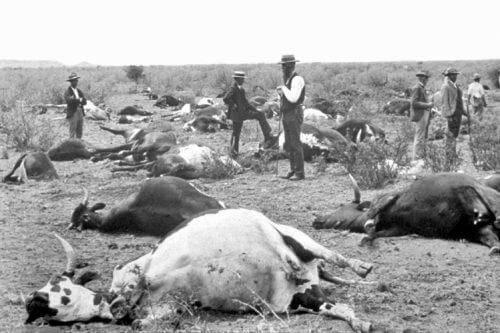Shepherds in the Zambezi Valley in Zimbabwe report a significant decrease in bites and harm to animals. Little by little the population of tsetsa flies is dwindling to such an extent that there are areas where the flies have completely disappeared. Farmers report that if until about ten years ago they lost animals with high frequency, then in recent years the injuries have stopped and there are no losses of farm animals

One of the factors that for many years limited the spread of cattle herds to large areas in Africa was the fly (Glossinidae). Its bite is painful, but more than that, it is the main carrier of the parasite (Trypanosoma) which causes "nagana" disease and death in farm animals and moreover causes sleeping sickness (African trypanosomiasis) and death in humans.
Farmers moved away from areas where the fly was and shepherds learned to prevent their herds from grazing in areas where the flies were common. One of the positive results of this was the fact that such areas remained natural without the damage of human settlement and activity, since over millions of years the wild animals developed "Protection" methods from bites and a high level of resistance against the parasite.
From the beginning of the XNUMXth century, white settlers pushed the locals who were forced to settle and graze even in infected areas and the results were damage to the natural environment and serious damage to farm animals and people.
One of the most talked about areas was the Zambezi Valley in Zimbabwe. The occupation of the territories north of South Africa that received the name Rhodesia resulted in white settlers in the area who pushed the locals to areas infested with flies in the Zambezi Valley and again the results were fatal. After gaining independence and changing the name to Zimbabwe, the natives remained in the valley and continued to suffer from the plague
Recently there has been a significant change in the situation. Shepherds in the valley report a significant decrease in bites and harm to animals. Little by little the population of tsetsa flies is dwindling to such an extent that there are areas where the flies have completely disappeared. Farmers report that if until about ten years ago they lost animals with great frequency, then in recent years the injuries have stopped and there are no losses of farm animals.
Where do the flies go?
The answer is found in a study published in the medical journal ( PLOS Medicine). According to the researchers, the reason for the disappearance of the flies is warming. Data collected from the "Mana Pools" reserve in the last 27 years showed that the rise in temperatures makes it difficult for the flies to survive. In 1990, researchers caught 50 flies on each cow every day, while in 2017 it took researchers 10 days to catch one fly on a cow. The conclusion is that the sleeping sickness will disappear from large areas in Africa, but the researchers warn that there is a possibility that the flies will migrate to cool areas, which until now had no flies. This is of course provided that there are plants and animals in these areas that the flies need to exist.
If at the beginning of the XNUMXth century, white ranchers settled in the cool areas, then today there is a chance that the tsetsa fly populations will also settle in the areas that were sought after by the whites.
More of the topic in Hayadan:

One response
Now, following additional studies
https://allafrica.com/stories/201811160888.html
It turns out that the heat damages the fertility of other male insects
And also in the fertility of mammals - including human males,
So maybe there are also benefits to warming up?